R.J. Stowell's Blog: rjsomeone, page 19
August 31, 2020
Meanwhile...
While the big guns of 1970 were 60s' icons (The Doors had 3 LPs in the top 100, the Beatles and Stones were in the top spots), there was plenty of new talent on the horizon (understatement of the year, 1970). Maybe you'll recognize this one.

As a young boy, Reginald Dwight spent five years at the Royal Academy of Music, his natural talent leading to an audition that left everyone awestruck. But Elvis and Buddy Holly would change the direction he'd take as a teenager, and then, in 1968, as part of a band called Bluesology, Reg answered an advertisement that read, "Liberty Wants Talent."
In the audition for Liberty Records, he was asked his name and chose Elton, just because he liked it, and John because of John Lennon. He was handed a stack of hand-scribbled poems by Bernie Taupin and asked that he write the music for them, the most famous among them, "The Border Song," truly classic Elton. His collaboration with lifelong lyricist, Bernie Taupin, had begun, and they'd never even met.
Fifty-one years ago, Elton's first LP, Empty Sky, was released in the U.K., an album that would not be released in America until 1975. The moderate success of the first LP left him doing session work for acts like The Hollies. Elton's debut in the States was his sophomore effort, Elton John, which had three hits in "Take Me To the Pilot," "The Border Song," and most famously, "Your Song," which remains as popular today, if not more so, than 50 years ago - the song has been streamed more than 100,000,000 times on Spotify alone.
A tremendously influential series of live performances at L.A.'s Troubadour proved that John - who'd been a huge Jerry Lee Lewis fan - could rock as hard as anyone, and before long his solo career was taking off on stage in both the U.K. and the U.S. and in the studio.
Bernie Taupin was born in 1950 at Flatters Farmhouse in the southern part of England. He was anything but a diligent student yet showed an early flair for writing and an appreciation for nature, for literature and narrative poetry, all of which influenced his lyrics. At age 15, he left school and started work as a trainee in the print room of the local newspaper, The Lincolnshire Standard with aspirations to be a journalist. He soon left and spent the rest of his teenage years hanging out with friends and hitchhiking the country roads. At age 16, he answered the advertisement that eventually led to his collaboration with Elton John.

Bernie's unique blend of influences gave his early lyrics a nostalgic romanticism that fit perfectly with the hippie sensibilities of the late 1960s and early 1970s. "Ballad of a Well-Known Gun," the lead song on Tumbleweed Connection, Elton's third LP, addresses the concerns of a man arrested for unspecified crimes yet showing deep remorse when he's thrown in prison by the Pinkertons. That kind of dusty verisimilitude seeps into "Song of Your Father" and "Talking Old Soldiers," and of course later in songs like "Sweet Painted Lady," "Roy Rogers" and "Have Mercy on the Criminal." Funny that Americana is captured so well by two nerdy Englishmen. Taupin's romantic lyrics are superb and brought to life with Elton's rising and falling piano chords, the mark of incredible teamwork. Elton, of course, is the voice and the music, but for me, as a writer and a teacher, it's Taupin's lyrics that bring me back and lately, bring me to tears. I love the storytelling in songs like "Blues For Baby and Me," kind of a follow-up to Springsteen's "Born to Run," about a young couple who run away by Greyhound, like in Paul Simon's "America."
50 years ago we had not yet heard or heard of Elton John, but six months later, we'd start singing "Your Song" and never stop.
Published on August 31, 2020 05:01
August 30, 2020
Waits and Me - Ramblings From 3am
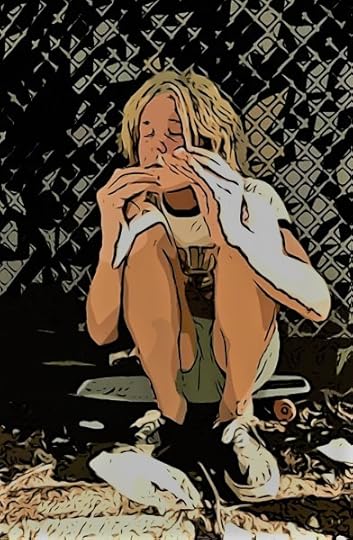 When I look at the gritty persona and the Bukowski stylings, I can't associate much with Tom Waits. His is a life I am both jealous and afraid of. But when he talks about the Sav-on and the heart of Saturday night, I find a lot of me in there. It's the storytelling where we mesh. Indeed, Waits and I have told so many different stories that it's difficult to distinguish fact from fiction.
When I look at the gritty persona and the Bukowski stylings, I can't associate much with Tom Waits. His is a life I am both jealous and afraid of. But when he talks about the Sav-on and the heart of Saturday night, I find a lot of me in there. It's the storytelling where we mesh. Indeed, Waits and I have told so many different stories that it's difficult to distinguish fact from fiction.Waits spent most of his youth in Whittier, California with his parents and two sisters. His father played Spanish guitar, his mother always singing, the house filled with music. Waits then learned piano from his neighbor.
There is so much "Jay" in that (of course, a shameless plug for Jay and the Americans). My neighbor in 7th grade was a woman who taught piano and worked in a piano bar on Roscoe Blvd. in the Valley. She'd written a hit for Frank Sinatra, and still she worked in a piano bar with a tip jar until 2:00 in the morning. She gave me free piano lessons and a key to her apartment, but I was as lazy as the day was long and her instruction never got me past Shaum's red book.
Like most of the kids, Waits had a gang of neighbor buddies and they were doing standard kid stuff - "Hanging around in the Sav-On parking lots and buying baseball cards" (from "Kentucky Avenue"). During one of his concerts in 1981, an incredible performance at McCabe's, Waits mentioned those little meaningful things from his childhood like having a tree fort, his first cigarette when he was seven, and being the neighborhood mechanic, repairing everyone's bicycles. When he was ten, his parents were divorced, and he moved with his mother and sisters to Chula Vista. He was fascinated by neighboring National City, a grimy suburb of San Diego, and here is where Tom was indoctrinated into a whole new world - he started hanging out with "pool hustlers, vinyl-booted go-go dancers, traveling salesmen and assorted gangsters." He was spending whole days watching movies at the Globe, a local movie theater, or playing on an old piano (which he got from a neighbor) in his garage. Tom acquired his appreciation for the blues while he was attending an all-black junior high school. There he became a huge fan of Ray Charles.
So that's some romantic shit right there; I was too afraid of life for that.
When he was fourteen, he worked at Napoleone's Pizza parlor. By then, music was the only thing that was important to Tom. He dropped out of school and began writing songs in earnest. Later he had a series of dead-end jobs like janitor, cook, dishwasher, cabdriver, fireman, delivery guy. Pretty much like all of us, but few of us have the opportunity to turn the mundane into genius.
You know that kid who everyone liked and the teacher thought was going to be a big star? The handsome guy who won the talent show and was popular with the ladies? Yeah, that wasn't him. Tom Waits said: "If I exorcise my demons, my angels may leave too" (from "Please Call Me, Baby"). When I wrote the character Maxwell Tennial (Max Ten), a young Waits was what I had in mind; a philosopher rogue who was popular despite himself – Tennial/Waits was who I wanted to be, my Tyler Durden, quoting Rimbaud and Hemingway. I didn't even come close, of course, just close to people like him – I was a disciple not a guru, but Waits, too, had the disciple in him, though his gurus were Bacon and Bukowski (mine, instead, was Walt Disney, and the Hari's on Hollywood Blvd - again, read Jay and the Americans).
That in mind, "Champaign for my real friends,/ Real pain for my sham friends" was actually from Francis Bacon, and from Rainer Maria Rilke, who rejected psychotherapy with the words, came the words, "If my devils are to leave me, I am afraid my angels will take flight as well." It's the sign of a good storyteller, steal from others without anyone even knowing. Thanks, Tom. Thanks, Max.
Published on August 30, 2020 13:36
August 29, 2020
Waits and Morrison, The Early 70s and the Tropicana Motel
1970 was quite a year for the Doors. Morrison Hotel was recorded and released at the beginning of the year, Elektra released both a Live LP and a compilation of hits called 13. By year's end, they were writing material for their last LP (as a foursome), L.A. Woman. It was in 1970 that, while Jim was falling apart, his voice matured to that of the consummate blues singer. I've been listening to both Morrison Hotel lately, and to L.A. Woman, what I consider the Doors' best, and one of the things that strikes me is the lessons that Tom Waits must have learned from Morrison. Or maybe it's just the similarity in their soaked in whiskey vocals. Both, by the way, lived, not that long apart, in a seedy L.A. motel called the Tropicana.
One-time Tropicana employee remembers the Trop on a typical day in the early 70s. "I was doing the night audit, and in came Tom. 'I want to watch Spartacus on TV,' he said. About that time a girl walked in. I didn't think she was a prostitute, so I rented her a room. Two minutes later her pimp pulls a gun on Nick Lowe from Rockpile. I'm calling the sheriff, and I got Tom Waits on the floor, rocking back and forth with a bottle of Cognac. Right then, four gay Filipinos came in. I gave them the room next to the office and not 15-minutes later they’re having an orgy in there, banging on the walls. Meantime the sheriff pulled up, and there’s a big confrontation in Nick Lowe’s room. At that point, a Mexican guy pulled in with his six kids in an old car. While they're in the office, his car caught on fire. Went up like a torch. He starts crying. The four guys are still banging on the wall. The cops are arresting the pimp. And, lastly, I got Tom Waits yelling, 'I love the scene of Spartacus on the hill!'" You could probably interchange a number of rock star's names for Waits, Morrison among them.
Waits once said: "I always had a great appreciation for jazz, but I'm a very pedestrian musician. I get by. I like to think that my main instrument is vocabulary." Jim may have felt the same way. There is something about both Waits and Morrison that screams out a film-noir version of L.A., a street-tough sensibility that might have Phillip Marlowe's narration as a voiceover.
Published on August 29, 2020 06:07
August 28, 2020
Jay and the Americans - A Memoir by R.J. Stowell - The Doors
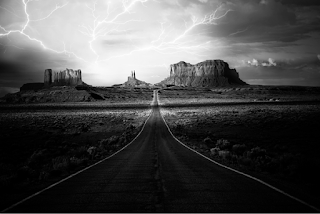 We were on the Navajo Trail in Monument Valley. I was eleven years old. On the radio, scratchy and fading in and out was the Doors' "Riders on the Storm." We had to pull over to the side because we just couldn’t see; the rain was thick like Karo syrup. The sky would flash, vivid like Vegas, brighter than day, stark fluorescent white. The monuments known as the Mittens would reach up out of the ground, silhouettes against the blazing white, huge black-mittened hands. Thunder: from the song on the radio, from the distance, from behind us. It was the kind of song you had to sing: "Into this house we're born. Into this world we're thrown." We pulled back onto the road as it let up, Morrison singing about the rain. We turned south on Devil's Highway.
We were on the Navajo Trail in Monument Valley. I was eleven years old. On the radio, scratchy and fading in and out was the Doors' "Riders on the Storm." We had to pull over to the side because we just couldn’t see; the rain was thick like Karo syrup. The sky would flash, vivid like Vegas, brighter than day, stark fluorescent white. The monuments known as the Mittens would reach up out of the ground, silhouettes against the blazing white, huge black-mittened hands. Thunder: from the song on the radio, from the distance, from behind us. It was the kind of song you had to sing: "Into this house we're born. Into this world we're thrown." We pulled back onto the road as it let up, Morrison singing about the rain. We turned south on Devil's Highway. 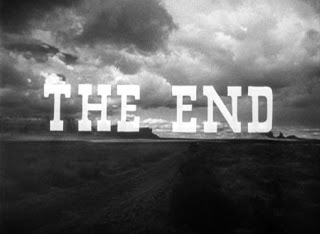 We passed a tiny building with red fluorescent letters that said, "KDK" across the top, a red and white radio tower pierced the sky behind it. As we pulled into town, the DJ played "Ghost Riders in the Sky" by Vaughn Monroe. I think he was just messing around, mixing the weather and the Doors and Vaughn Monroe, but it was a song my father knew. He sang it in a deep monotone and he knew all the words. He sang "Yipee-i-a, yippee-iii-o." We were in the heart of Injun territory and my father was singing, "Yipee-i-o."
We passed a tiny building with red fluorescent letters that said, "KDK" across the top, a red and white radio tower pierced the sky behind it. As we pulled into town, the DJ played "Ghost Riders in the Sky" by Vaughn Monroe. I think he was just messing around, mixing the weather and the Doors and Vaughn Monroe, but it was a song my father knew. He sang it in a deep monotone and he knew all the words. He sang "Yipee-i-a, yippee-iii-o." We were in the heart of Injun territory and my father was singing, "Yipee-i-o." Just as suddenly as it had come, the thunderstorm passed and the sun came out over the grand red rocks in the distance. Back toward the valley it was still black as pitch and in for it. We stopped in a diner. We had breakfast for dinner, cowboy style, a juicy red steak and a fried egg, a big stack of buttered toast. I bought a postcard of the mittens and one of El Capitan, which the Navajo call, "Aghaałą́." Monument Valley was like a lot of things: there were beautiful parts surrounded by a whole lot of nothing.
 At the junction where the road veers off toward Canyon de Chelly was a Navajo outpost, a crude wood and corrugated metal shack. Near the highway Navajo blankets were on display. The colors were less than varied, always the same neutral shades of sand or dried brush, but always a deep color crimson bordered in black. In the shack was a loom and an Indian woman at work. There were hundreds of wool threads that covered the spectrum of muted color from dark to light hanging on hooks by the loom. The woman was gray haired, her face weathered, and she had on thick reading glasses. I took pictures. One blanket in particular was beautiful; a Navajo representation of water in gray and red and black with a dragonfly in the center. I wanted it so bad. It was $40. My father recognized how much I appreciated the blanket and said, "I will buy that for you, but nothing else. You can spend your own money on postcards." The radio was on in the background, kind of a surreal juxtaposition, and a voice said, "This is KDK and these are The Doors." A beautiful Navajo girl came out from the back room wearing jeans and a chambray blouse singing "Love Her Madly." She looked at me, raised her brow and sang, "Don't you love her ways," and I nearly passed out.
At the junction where the road veers off toward Canyon de Chelly was a Navajo outpost, a crude wood and corrugated metal shack. Near the highway Navajo blankets were on display. The colors were less than varied, always the same neutral shades of sand or dried brush, but always a deep color crimson bordered in black. In the shack was a loom and an Indian woman at work. There were hundreds of wool threads that covered the spectrum of muted color from dark to light hanging on hooks by the loom. The woman was gray haired, her face weathered, and she had on thick reading glasses. I took pictures. One blanket in particular was beautiful; a Navajo representation of water in gray and red and black with a dragonfly in the center. I wanted it so bad. It was $40. My father recognized how much I appreciated the blanket and said, "I will buy that for you, but nothing else. You can spend your own money on postcards." The radio was on in the background, kind of a surreal juxtaposition, and a voice said, "This is KDK and these are The Doors." A beautiful Navajo girl came out from the back room wearing jeans and a chambray blouse singing "Love Her Madly." She looked at me, raised her brow and sang, "Don't you love her ways," and I nearly passed out.Jay and the Americans is available all over the world!
CreateSpace - Amazon - Amazon UK - Amazon France - Amazon Russia
Published on August 28, 2020 05:58
August 26, 2020
The Doors of Perception - 1970
 It's amazing that there could be so much incredible music simultaneously. The Billboard album Top 10 in September 1970 included Let It Be, Let It Bleed, Deja Vu, Tea for the Tillerman, Moondance, the Doors Live and Morrison Hotel (and that only scratches the surface). Yet more productive than any other band that year, was the Doors.Now, in 1970, it was obvious that Elektra Records liked the young, slim, sexy Jim far more than the fat one he'd become. Both the live album released that year and the compilation, 13, had photos of Morrison from a younger, less alky, day; no beard, no belly. But for those who were really there for the music and not the soap opera that was Mr. Mojo, Jim's voice simply got better with age. You could hear it on Morrison Hotel, but this was the late 60s and artists had to quickly get out another one; the Doors were preparing for L.A. Woman before summer was over. (Morrison Hotel was recorded in December 1969 and January 1970.)
It's amazing that there could be so much incredible music simultaneously. The Billboard album Top 10 in September 1970 included Let It Be, Let It Bleed, Deja Vu, Tea for the Tillerman, Moondance, the Doors Live and Morrison Hotel (and that only scratches the surface). Yet more productive than any other band that year, was the Doors.Now, in 1970, it was obvious that Elektra Records liked the young, slim, sexy Jim far more than the fat one he'd become. Both the live album released that year and the compilation, 13, had photos of Morrison from a younger, less alky, day; no beard, no belly. But for those who were really there for the music and not the soap opera that was Mr. Mojo, Jim's voice simply got better with age. You could hear it on Morrison Hotel, but this was the late 60s and artists had to quickly get out another one; the Doors were preparing for L.A. Woman before summer was over. (Morrison Hotel was recorded in December 1969 and January 1970.)Time for a commercial...I think the wonderful part of Calif. by R.J. Stowell is that as you read, you get to experience the California of 50 years ago, and in 1970, this happened (and it's just page 1):
 “I love the places I’ve never been,” she said. Farmgirl stared out the window like a puppy. “There it is!” I knew where it was; I’d grown up in L.A. Barney’s Beanery, Santa Monica Blvd., the beginning or the end of Route 66. We took a booth by the pool table. There was a book of matches in the ashtray that said, “Fagots Stay Out.”
“I love the places I’ve never been,” she said. Farmgirl stared out the window like a puppy. “There it is!” I knew where it was; I’d grown up in L.A. Barney’s Beanery, Santa Monica Blvd., the beginning or the end of Route 66. We took a booth by the pool table. There was a book of matches in the ashtray that said, “Fagots Stay Out.”Two guys who looked like Jim Morrison were playing Eight Ball and arguing. The first was the young Jim; the other, the fat one with the beard. I liked them both. I had a chili-size and Hadley, Farmgirl, had a vanilla Coke and an order of fries with gravy. As the waitress walked away she said, “Gravy is so much better than ketchup it’s not even worth talking about.”
When the Morrisons left, Farmgirl jumped up to grab the table. She stood at the register with a dollar bill and got quarters from a scroungy old man who shaved his gray whiskers like a poorly mown lawn. She pushed her quarter into the slot and the balls tunneled down.
Back to our program...Okay, back to the Doors and the fat Jim. On Morrison Hotel the band was clearly returning to its blues roots, but for L.A. Woman, arguably the Doors' greatest achievement, each simply excelled. Morrison Hotel was a comeback of sorts, fusing a newfound appreciation for blues with the group's early sound. With few exemptions, L.A. Woman reveals how the band left behind the pop flavors of their salad days in favor of straight-ahead, grungy blues.L.A. Woman’s bluesy existential bent and its bar band R&B flow freely on the two hardest cuts, "Been Down So Long" and "Cars Hiss By My Window," oddly stripped of Ray Manzarek's trademark keyboard. It shows the incredible musicianship of Manzarek, who knew when to keep it low. The title cut is a strong rocker where the instruments rip and burn, a testament to a city as the ultimate femme fatale, a place Morrison viewed as diseased and alienating. "L'America" is the third rail here, a potent psychedelic chestnut rejected from Antonioni's "Zabriskie Point" but it has an odd otherwordly energy, as does Robbie Kreiger's "Love Her Madly." Pretty good when these are the weakest tunes on the album. "Riders On The Storm" fittingly closes the LP with a strong jazzy sensibility and ominous thunder and rain, a sad testament to a life lived on the edge of the abyss. L.A. Woman is a fitting "signing off" from the Lizard King.And here's my recommendation – but caution, I've evolved since the isolation began – buy this LP on 180-gram vinyl. That's right, you heard it from me, buy new! In my vintage stereo days, I would never have said this, but having switched up to PS Audio and an audiophile turntable, I'm embracing new vinyl anew. While the 180-gram part is a gimmick (but not for 70s era RCA Dynaflex LPs – which were horrible – definitely replace your old Bowie), the remastering of L.A. Woman for the 2019 vinyl release is magic. The stereo separation is sublime, and the lack of surface noise reveals the pressing we've waited for for nearly 50 years.
Published on August 26, 2020 06:00
August 25, 2020
50 Years On - Beggar's Banquet
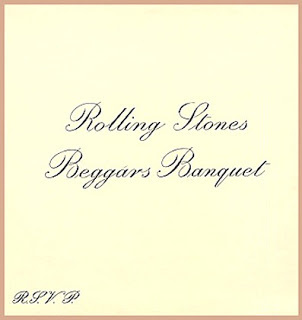 "We were starting to find the Rolling Stones," Keith Richards said during the Beggar's Banquet sessions — it's a pretty bold statement from the man who created the single most iconic guitar riff in rock music with "Satisfaction" in 1965. And yet, if one takes the remark to mean "We were carving in stone the dictionary definition of the Rolling Stones," then it's fairly accurate. Despite the myriad of hits from the mid-sixties incarnation of the band, the Stones had always been in The Beatles' shadow.
"We were starting to find the Rolling Stones," Keith Richards said during the Beggar's Banquet sessions — it's a pretty bold statement from the man who created the single most iconic guitar riff in rock music with "Satisfaction" in 1965. And yet, if one takes the remark to mean "We were carving in stone the dictionary definition of the Rolling Stones," then it's fairly accurate. Despite the myriad of hits from the mid-sixties incarnation of the band, the Stones had always been in The Beatles' shadow. Several factors converged together by early 1968 to ensure that transformation. First, music was evolving, and the Stones — Mick Jagger in particular — were anxious about missing those precious relevant trends that would ensure their remaining on top. "Englishness," à la Ray Davies, was not one of those trends: the Kinks were beginning to lose their commercial appeal (and of course were particularly unknown in the U.S.), and Mod culture in the U.K. was dissipating. The flower power thing, having peaked in The Summer of Love, suffered the same fate. On the other hand, the roots revival, exemplified by Dylan and the Byrds, seemed to be gaining the upper hand. And once Hendrix and the Who opened the floodgates for experimental electric guitar, successful hard rock acts began pouring in. It didn't take long for the Stones to learn which way the wind was blowing.
By 1968, Brian Jones was no longer a vital presence in the band: drugs coupled with psychological issues reduced him to a ghost of his psychedelic self, even as Keith, whose own drug problem was hardly any better, found the discipline to hold the rudder. Although there's little doubt that Mick and Keith cheated Brian out of songwriting credits, he was still an integral part of the band's sound with all the exotic instrumentation and psychedelic flavor. "No Expectations" would have been bland without Brian's slide; "Parachute Woman" would be less haunting without his harmonica; "Street Fighting Man" less tense and ominous without his sitar. These elements offer vital links with the Stones' recent past, turning Beggars Banquet into something larger than just a "roots-rock" album and adding enough mystery and psychologism to suggest that even at this point, it may not yet have been too late for Brian to clean up his messy act and reassert his place in the band. Beggars Banquet is the one album, out of the big four of 1968-72 to appeal the most to all those who typically prefer the pop era of the Stones. Novice Stones fans would be wise to start with Flowers, the Stones' pop compilation, and Beggar's Banquet.
Some of you are asking, Why now? Indeed, the LP is 52 years old and the box set reissue came out in 2018. My philosophies have evolved since the pandemic. Time has given me the ability to more fully experience my new equipment. I'd always gone vintage and still have my Magnavox turntable from 1961, but I listen now on my U-Turn turntable and my PS Audio receiver. It's midrange audiophile with the system costing less than $2500. For us, that was an extravagance and I waited a long time. With the new system and the time, I am appreciating new vinyl more and more. I love my collectibles, but despite the shoddy craftsmanship of some new pressings, I've found that many, if not most, newly pressed LPs from solid labels, make a remarkable difference. I started this trend because of Bowie whose 70s pressings on RCA were of substandard quality. I got new pressings of Low, Hunky Dory and Ziggy on Polydor and the difference is phenomenal. My most recent purchases are the Doors L.A. Woman and Beggars Banquet. The box set is gorgeous and sounds incredible.
On Beggars Banquet, the Stones laid down an amazing mix of acoustic and country flavors atop a sturdy and weathered blues and rock foundation to create a splendid album; not as good as Let It Bleed, but getting there. The recording is chock-full of FM radio classics but it's the less popular tracks where the band shines. "No Expectations" features one of Brian Jones most meaningful and, sadly, last contributions to the band's history with his easy going and smooth slide work. "Jigsaw Puzzle" shows some of the Stones' Dylan influence, and "Parachute Woman" is a chugging acoustic blues exercise. As for the staples, "Street Fighting Man" has some of the most disquieting acoustic work ever laid down and "Sympathy for the Devil," well...what can you say? I
Among some of the greatest Stones' songs included herein, Beggars Banquet demonstrates how vital Keith Richards is as a guitarist. He may not play with lightning speed and his lead is limited at times, but a unique and hypnotic rhythym style and an undeniable gift for melody and song-crafting are second to none.
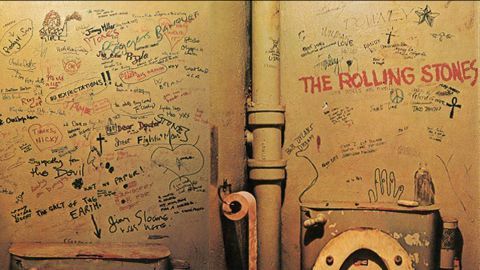
Published on August 25, 2020 05:32
Repost: The Total Eclipse of Brian Jones
 Brian Jones, alongside Richards and Jagger, formed The Stones in 1962, with Jones the key player, the catalyst behind the name and their blues edge. That distinction would carry on through the cover years (1962 to 1965), when finally Jagger and Richards would put pen to paper and determine not merely to write LP filler. The band was known early on for highlighting songs by Lennon/McCartney, Sonny Bono, Jerry Lieber or Chuck Berry, a concept not dissimilar to Vanilla Fudge. Though a satisfying venture into blues, The Stones through Out of Our Heads were essentially a tribute band ("Satisfaction," the quintessential Stones track, was only released on LP in the U.S.). Even the follow up LP, December's Children, featured only five (of 12) songs by the fledgling composers. The Stones wouldn't really come into their own until Aftermath in 1966. From there, they took on the Beatles rivalry that had always been the job of The Beach Boys.
Brian Jones, alongside Richards and Jagger, formed The Stones in 1962, with Jones the key player, the catalyst behind the name and their blues edge. That distinction would carry on through the cover years (1962 to 1965), when finally Jagger and Richards would put pen to paper and determine not merely to write LP filler. The band was known early on for highlighting songs by Lennon/McCartney, Sonny Bono, Jerry Lieber or Chuck Berry, a concept not dissimilar to Vanilla Fudge. Though a satisfying venture into blues, The Stones through Out of Our Heads were essentially a tribute band ("Satisfaction," the quintessential Stones track, was only released on LP in the U.S.). Even the follow up LP, December's Children, featured only five (of 12) songs by the fledgling composers. The Stones wouldn't really come into their own until Aftermath in 1966. From there, they took on the Beatles rivalry that had always been the job of The Beach Boys.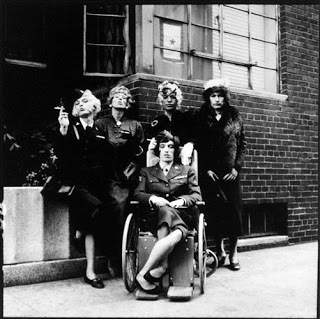
The Stones rise to power was in direct correlation to the eclipse of Brian Jones. Jones had always been the spiritual leader of the band, despite Jagger's vocals and Richards' role as lead guitar. Jones on Rolling Stones Now!, for instance, is credited with guitar and slide guitars, harmonica and backing vocals, while being instrumental in The Stones covering the likes of Willie Dixon. On Out of Our Heads, the lessened role is nearly imperceptible, but there nonetheless, with Jones credited to guitar on seven tracks, acoustic guitar and harmonica on one. For the next three LPs, Aftermath, Between the Buttons and Her Satantic Majesties, the role as vocalist and guitarist was diminished, with the addition of odd instruments (wisely added to the band's bluesy sound) like the dulcimer, marimba, banjo, even the kazoo. Jones indeed was part George Harrison, part Syd Barrett.
Inspired by George Harrison's Indian excursions, Jones would later don the role of Eastern spiritual adviser, at least when it came to instrumentation, but not until Beggar's Banquet. By Let it Bleed, though, Jones' eclipse (call this the path of totality), was readily apparent, with the band founder playing only the congas on "Midnight Rambler" and the autoharp on "You Got Silver." The LP, of course would be The Stones last of the 60s, and the last LP with Jones' input. While Harrison was coming into his own, and Barrett was wallowing in psychedelics, Brian Jones had found a darker, back way out.
Published on August 25, 2020 05:09
August 24, 2020
The Rolling Stones - Sympathy For The Devil - 50 Years
It is truly amazing the transformation over a two year period from the release of "Dandelion" and Her Satanic Majesty's Request in 1967. Many, like this writer, are of the opinion the Stones' found themselves and took charge with the demise of the Beatles. Beggar's Banquet and Let It Bleed are the proof.
While Let It Bleed came out before Let It Be, the name is a parody of the Beatles' LP, which was initially scheduled for release prior to the Stones' most celebrated LP.
Published on August 24, 2020 05:17
August 23, 2020
Merry Clayton - 50 Years Ago
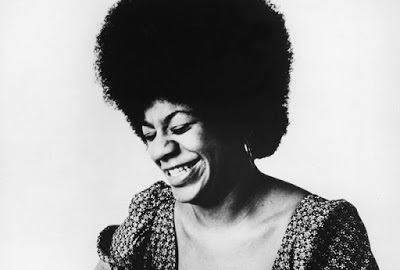 Merry ClaytonThe AM radio show, heard Fridays on iHeart Radio and at Daybreak USA (click on the sidebar), recently highlighted the seminal performances of two of rock's greatest singers; two women whose names you probably don't know: Clare Torry, whose gospel vocal on Pink Floyd's "The Great Gig in the Sky" is one of rock's shining moments; and Merry Clayton on the Rolling Stones' "Gimmer Shelter." While a myriad of rock's greatest singers have legions of familiar offerings, there are those whose repertoire consists of just one song, and that's all we need.
Merry ClaytonThe AM radio show, heard Fridays on iHeart Radio and at Daybreak USA (click on the sidebar), recently highlighted the seminal performances of two of rock's greatest singers; two women whose names you probably don't know: Clare Torry, whose gospel vocal on Pink Floyd's "The Great Gig in the Sky" is one of rock's shining moments; and Merry Clayton on the Rolling Stones' "Gimmer Shelter." While a myriad of rock's greatest singers have legions of familiar offerings, there are those whose repertoire consists of just one song, and that's all we need.Imagine "Great Gig" with just Wright's tune and keys and Gilmour's slide guitar – still phenomenal, but, come on…
Same with "Gimme Shelter." Keith's "freaky, tremolo-drenched riff is something straight out of the future — or at least "a very chilling alternate present,” as Guitar World put it, but remove Merry Clayton's howl and yowl and what have you got? A pretty good Stones tune but again that's all.
Jagger remembers that "we randomly phoned up this poor lady in the middle of the night, and she arrived in her curlers and proceeded to do that in one or two takes, which is pretty amazing. She came in and knocked off this rather odd lyric. It’s not the sort of lyric you give anyone — 'Rape, murder/It’s just a shot away' — but she really got into it, as you can hear on the record." Pregnant and getting ready for bed before she got the call from producer Jack Nitzsche, Merry politely bowed out until her husband said: "Honey, you know, you really should go and do this date." The incredible performance, though, would indeed turn tragic. That night, Clayton miscarried.
Merry, though, turned what is assuredly a good song – but no more – into rock canon.
Published on August 23, 2020 06:41
Let It Bleed
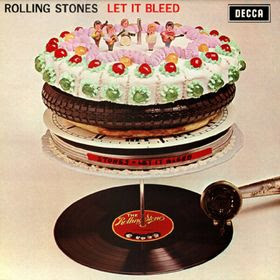 Throughout the 1960s, the Rolling Stones were consistently overshadowed by the Beatles. Despite 1968's stellar Beggars Banquet,among the greatest albums ever recorded, the Stones played second fiddle. Of course, the immensity of the Beatles is undeniable. Think about it: in 1967 the Beatles released both Sgt. Pepper and Magical Mystery Tour. Critically speaking, more often than not, Sgt. Pepper is considered the greatest album ever recorded, and "Strawberry Fields" the greatest single. The first worldwide television broadcast, Our World, in 1968 featured the Beatles as the British component in a live recording of "All You Need is Love." Watch that video to find good friends Mick Jagger and Keith Richards essentially backing the Beatles. 1968 would also bring "Hey Jude" and The White Album, and 1969 Abbey Road. While Her Majesties Satanic Request was a pale comparison to Pepper, Beggars Banquet was its peer. If you're going to be in someone's shadow, it may as well be the Beatles; nonetheless…
Throughout the 1960s, the Rolling Stones were consistently overshadowed by the Beatles. Despite 1968's stellar Beggars Banquet,among the greatest albums ever recorded, the Stones played second fiddle. Of course, the immensity of the Beatles is undeniable. Think about it: in 1967 the Beatles released both Sgt. Pepper and Magical Mystery Tour. Critically speaking, more often than not, Sgt. Pepper is considered the greatest album ever recorded, and "Strawberry Fields" the greatest single. The first worldwide television broadcast, Our World, in 1968 featured the Beatles as the British component in a live recording of "All You Need is Love." Watch that video to find good friends Mick Jagger and Keith Richards essentially backing the Beatles. 1968 would also bring "Hey Jude" and The White Album, and 1969 Abbey Road. While Her Majesties Satanic Request was a pale comparison to Pepper, Beggars Banquet was its peer. If you're going to be in someone's shadow, it may as well be the Beatles; nonetheless…1969 however, was that transitional year when the Rolling Stones began the takeover as the greatest rock band in the world. The transition started with Banquet, but more impressively continued with Let It Bleed.
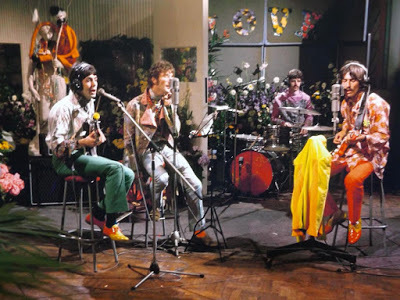 As an aside, keep in mind that the title, Let It Bleed, is a play on the Beatles' Let It Be, and appropriate for the bad boys of rock. I've mentioned this on the air before only to get flack because Let It Bleedwas released the year prior to Let It Be. Although that's the case, Let It Bewas recorded long before Abbey Road. It's the order of the releases that's confusing.
As an aside, keep in mind that the title, Let It Bleed, is a play on the Beatles' Let It Be, and appropriate for the bad boys of rock. I've mentioned this on the air before only to get flack because Let It Bleedwas released the year prior to Let It Be. Although that's the case, Let It Bewas recorded long before Abbey Road. It's the order of the releases that's confusing.Let It Bleed was recorded throughout 1969 in a tumultuous time for the Stones who were having as much trouble with Brian Jones, the same kinds of trouble, as Pink Floyd had with Syd Barrett. Illicit drug use, LSD, and an over the top rock 'n' roll lifestyle brought the downfall of both. Jones in 1969 participated in the production of Let It Bleed on a minimal level. And remember, this wasn't Mick's band or Keith's band, the Rolling Stones were Brian Jones' band, and now he was participating in a superfluous way that midyear led to his firing from the Rolling Stones and his death just a month later. That only emphasizes Keith Richards' role as the band's guitarist. While Mick Taylor replaced Jones, he too played a minimal role in the album's production, leaving the vast majority of guitar lead and rhythm to Richards. Work on the album began in November 1968 with "You Can't Always Get What You Want," a part of the Beggars Banquet sessions, but Let It Bleed's production began in earnest in February 1969.
 The stones were busily working on Let It Bleed with the release date scheduled for June 1969. Subsequently, there was no interest in Woodstock for the band and like Led Zeppelin, an American tour was scheduled instead. Because of the delays associated with Brian Jones mal-adventures, and the release of "Honky-Tonk Woman" as a single in July 1969, the album's release was pushed back until the Stones' American tour ended in December 1969. That tour led to the Live LP Get Yer Ya-ya's Out, the first live LP ever to make it to No. 1 on the British charts, released by Decca Records in response to the bootleg, Liver Than You'll Ever Be.
The stones were busily working on Let It Bleed with the release date scheduled for June 1969. Subsequently, there was no interest in Woodstock for the band and like Led Zeppelin, an American tour was scheduled instead. Because of the delays associated with Brian Jones mal-adventures, and the release of "Honky-Tonk Woman" as a single in July 1969, the album's release was pushed back until the Stones' American tour ended in December 1969. That tour led to the Live LP Get Yer Ya-ya's Out, the first live LP ever to make it to No. 1 on the British charts, released by Decca Records in response to the bootleg, Liver Than You'll Ever Be.Let It Bleed was recorded both in London at Olympic Studios and in Los Angeles at Electra Sound Recorders where we can add Merry Clayton to the mix with the performance of a lifetime on "Gimme Shelter." When Let It Bleed was released in December 1969 at the top of the UK charts, it displaced, if temporarily, Abbey Road. Based on the success of Abbey Road in the US, of course, the most important market, Let It Bleed only made it to No. 2 on the Billboard Top 100, but was certified double platinum early in 1970. There is a six-album canon from the Rolling Stones, Beggars Banquet, Let It Bleed, Sticky Fingers, Exile on Main Street, Goat's Head Soup and It's Only Rock 'n Roll that define the Stones' status as the Beatles' successors; Let It Bleed at the top of the list.
Published on August 23, 2020 06:37



